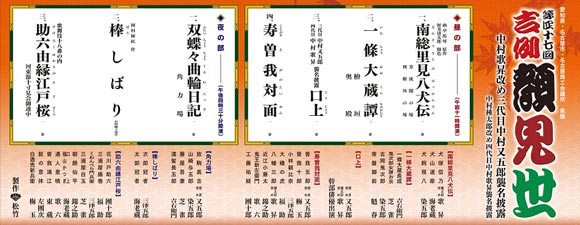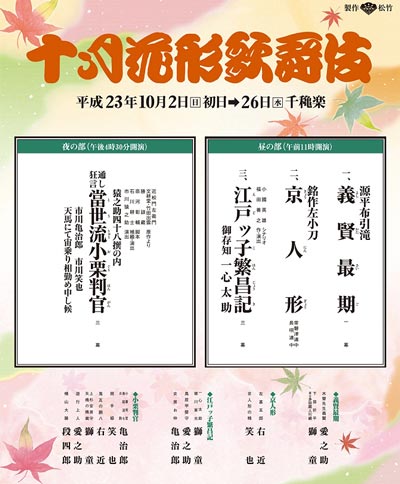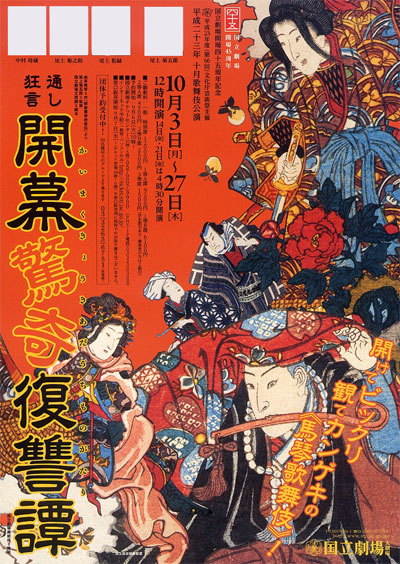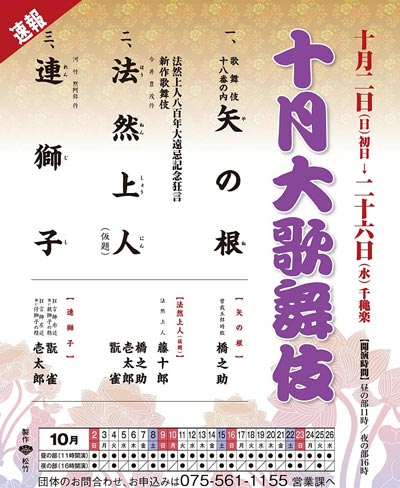| OCTOBER 2011 |
|
2 shows in Nagoya (Misonoza), 5 in T˘ky˘ (Shinbashi Enbuj˘, National Theatre, NHK Hall, Nissay Theatre), 1 in Ky˘to (Minamiza), 1 in Yoshinoyama (Kinpusanji) and 2 in Kagoshima (Mishima-mura Kabuki, Kagoshima ďkabuki)!
|
| Misonoza (Nagoya) |  |
| Dates | 1 ~ 25 October 2011 (Kichirei Kaomise ďkabuki) Annual Festive Face-Showing Grand Kabuki |
| MatinÚe | |
| Evening | |
| Casting |
Ichikawa Danjűr˘, Nakamura Kichiemon, Band˘ Mitsugor˘, Nakamura Baigyoku, Nakamura Matagor˘, Nakamura Shibajaku, Nakamura Kaishun, Nakamura Fukusuke, Ichikawa Ebiz˘, Nakamura Kash˘, Ichikawa Sadanji, Nakamura Kinnosuke, Nakamura Karoku, Nakamura T˘z˘, Ichikawa Somegor˘ |
| Comments |
47th kaomise at the Misonoza, which celebrates two shűmei: Nakamura Kash˘ III and his son Nakamura Tanetar˘ IV take the respective names of Nakamura Matagor˘ III and Nakamura Kash˘ IV.
|
 |
| Shinbashi Enbuj˘ (T˘ky˘) |
| Dates | 2 ~ 26 October 2011 (Jűgatsu Hanagata Kabuki) Young Actors October Kabuki |
| MatinÚe |
Genpei Nunobiki no Taki Meisaku Hidari Kogatana (Ky˘ Ningy˘) Edokko Hanj˘ki (Gozonji Isshin Tasuke) |
| Evening | |
| Casting |
Kataoka Ainosuke, Ichikawa Danshir˘, Ichikawa Kamejir˘, Ichikawa Ukon, Ichikawa Emiya, Nakamura Shid˘ |
| Comments |
|
 |
| National Theatre (T˘ky˘) |
| Dates | 3 ~ 27 October 2011 |
| Program |
Kaimaku Ky˘ki Adauchi Monogatari |
| Casting |
Onoe Kikugor˘, Nakamura Tokiz˘, Onoe Kikunosuke, Onoe Sh˘roku |
| Comments |
"Kaimaku Ky˘ki Adauchi Monogatari" is a Kabuki version of Kyokutei Bakin's novel "Kaikan Ky˘ki Ky˘kakuden", "Daring Adventures of Chivalrous Men", 4 volumes which were published between 1832 and 1835.
|
 |
|
|||
| Dates | 2 ~ 26 October 2011 (Jűgatsu ďkabuki) October Grand Kabuki |
||
| Program |
Sumizome no Nenbutsu Hijiri |
||
| Casting |
Sakata T˘jűr˘, Nakamura Kanjaku, Nakamura Hashinosuke, Nakamura Kazutar˘ |
||
| Comments |
"Sumizome no Nenbutsu Hijiri" is a newly-created Kabuki drama, which is staged to commemorate the Buddhist priest H˘nen (1133~1212).
|
||
 |
|
|||
| Dates | 2 ~ 26 October 2011 (Band˘ Tamasabur˘ Tokubetsu Buy˘ K˘en) Band˘ Tamasabur˘ Special Dance Performances |
||
| Program |
Y˘kihi |
||
| Casting | |||
| Comments |
|
||
| NHK Hall (T˘ky˘) | |
| Dates | 28 October 2011 (Koten Gein˘ Kansh˘ Kai) |
| Program |
Hikosan Gongen Chikai no Sukedachi
|
| Casting |
Nakamura Kichiemon, Nakamura Shibajaku, Nakamura Matagor˘, Nakamura T˘z˘ |
| Comments |
38th edition of Koten Gein˘ Kansh˘ Kai (literally the "Classics Entertainment Appreciation Association"), a yearly performance produced by the National TV network NHK. The program includes one ky˘gen, one Kabuki play, one traditional dance and traditional music.
|
| Kinpusanji Temple (Yoshinoyama) | |
| Dates | 8 ~ 9 October 2011 (Yoshino Gein˘sai Kinpusanji H˘n˘ Kabuki) Yoshino Artistic Festival Kinpusanji Offering Kabuki |
| Program | |
| Casting | |
| Comments |
Original outdoors Kabuki performance, in the precincts of the famous Kinpusanji temple which is located in the heart of Yoshinoyama:
|
| I˘jima Island (Kagoshima) | |
| Dates | 22 October 2011 (Mishima-mura Kabuki) Mishima Village Kabuki |
| Program | |
| Casting |
Nakamura Kanzabur˘, Kataoka Kamez˘, Nakamura Shichinosuke, Nakamura Kantar˘, Nakamura Tsurumatsu, Nakamura Kannoj˘ |
| Comments |
Original outdoors Kabuki performance on the Island of I˘jima, one of the 3 islands of the Mishima Village, which belongs to the Kagoshima City. I˘jima is 5.5 kilometres in length from east to west and 4.0 kilometres from north to south. Historically it is identified as Kikai Island, an island of exile, where the priest Shunkan was exiled. A real boat will be used instead of the usual stage prop! This outdoors right-on-location "Shunkan" performance was premiered 15 years ago. This time is the second edition.
|
| Kagoshima Citizens' Culture Hall (Kagoshima) | |
| Dates | 25 October 2011 (Kagoshima ďkabuki) Kagoshima Grand Kabuki |
| Program | |
| Casting |
Nakamura Kanzabur˘, Kataoka Kamez˘, Nakamura Shichinosuke, Nakamura Kantar˘, Nakamura Tsurumatsu, Nakamura Kannoj˘ |
| Comments |
1-evening only Kabuki performance in the city of Kagoshima.
|
|
|
| Contact | Main | Top | Updates | Actors | Plays | Playwrights | Programs | Links | FAQ | Glossary | Chronology | Illustrations | Prints | Characters | Derivatives | Theaters | Coming soon | News |